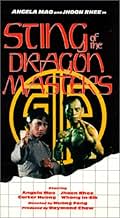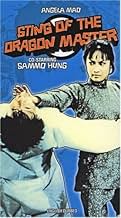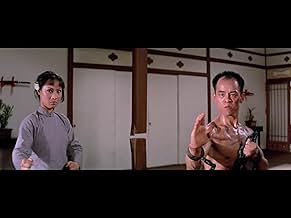NOTE IMDb
6,4/10
317
MA NOTE
Ajouter une intrigue dans votre langueDuring the Japanese occupation of Korea, the leader of a resistance movement, who's also a Taekwondo master, and his apprentices struggle against the brutal Japanese occupiers, aided by a Ch... Tout lireDuring the Japanese occupation of Korea, the leader of a resistance movement, who's also a Taekwondo master, and his apprentices struggle against the brutal Japanese occupiers, aided by a Chinese female martial artist.During the Japanese occupation of Korea, the leader of a resistance movement, who's also a Taekwondo master, and his apprentices struggle against the brutal Japanese occupiers, aided by a Chinese female martial artist.
- Réalisation
- Scénario
- Casting principal
Carter Wong
- Jin Zheng Zhi
- (as Carter Huang)
Avis à la une
I first saw "When Taekwondo Strikes" over twenty years ago via a panned and scanned (and dubbed) VHS copy, and at the time I didn't think too much of it. But recently I got the opportunity to see it again this time with an anamorphic widescreen DVD edition that had the original Mandarin track and English subtitles. This better edition may explain why my feelings about the movie improved. Certainly, the movie is not perfect. It has some of the clichés associated with old school kung fu movies (chortling villains, exaggerated sound effects, etc.) There's not a terrible amount of plot, which results in some lengthy slow spots. And the Japanese villains could have been made into stronger opponents instead of being shown to be (mostly) hopeless. On the other hand, despite the largely one-sided fights, the martial arts scenes aren't too bad, having excitement and coming across as fairly believable. Angela Mao makes for a charismatic protagonist, and there's fun seeing a pre- fame Sammo Hung as one of the villains. I'm generally not a fan of old school Hong Kong marital arts movies, but I have to admit that this one was, despite its flaws, definitely above average.
"Sting of the Dragon Masters" features Jhoon Rhee in his only martial arts film role. Rhee, who is known as the 'Father of American Tae Kwon Do' and counts Muhammad Ali among his students, plays a humble, unassuming man living in Japanese-occupied Korea in the early twentieth century. He makes every effort to conceal his martial skill, but is eventually forced to lash out against the Japanese oppressors. (In this regard, and also because it is a Golden Harvest production, "...Dragon Masters" bears more than a passing resemblance to Bruce Lee's "The Chinese Connection".) Fighting alongside Rhee are chop-socky stalwarts Angela Mao Ying and Carter Wong, while the seemingly endless array of villains includes Whang Ing-Sik (dressed in a very loud kimono) and Sammo Hung. As is the case with many martial arts films, the storyline is simple and exists primarily to link the fight scenes together. But, good god, what fight scenes they are! "Sting of the Dragon Masters" offers spectacular, jaw-dropping action, with a special focus on kicks (as you might expect from a film whose alternate title is "When Tae Kwon Do Strikes"), and you'll certainly feel that you've gotten your money's worth by the time the closing credits roll.
The DVD version released by Crash Cinema was very poorly done. The mastering engineer must have been either drunk, asleep or not even in the room while it was being done. It looks like it was mastered from about a tenth generation copy and about halfway through the film, the audio synchronization disappears. The dialog is about 10 or 15 seconds behind the audio. If you're thinking about purchasing this DVD, please save your money. I remember seeing this film at the theater back in 1973. Also, the VHS copy of this film under the title of "When Taekwondo Strikes" looks better than the DVD, but the remaining several minutes of the movie are "missing". Where is the original camera negative?
STING OF THE DRAGON MASTERS (1973, aka WHEN TAEKWONDO STRIKES) is an unusual kung fu film set largely in Korea during the Japanese occupation in the 1930s and involves an ethnically mixed cast of Chinese, Korean, Japanese and American martial artists. Korean Taekwondo expert Jhoon Rhee plays the leader of the Korean resistance movement and his group includes a Chinese hapkido expert played by Angela Mao, a Korean Taekwondo expert played by Carter Wong, and an American student of the art played by Anne Winton, who has seen her uncle, a Catholic priest, abducted, tortured and finally killed by the Japanese occupying forces. ('The Japs have no respect for religion,' we are told.) A long-haired Samo Hung appears as one of the Japanese karate experts who takes on the heroes in several fights. (He also played a Japanese villain in King Hu's THE VALIANT ONES, 1974.)
The plot centers around the efforts of Rhee to keep his resistance movement alive after being exposed to the Japanese and get a list of his rebel group's members to their contacts in China. This involves lots of fights in the first half of the movie, including at least three in a Catholic church and one in a restaurant. The final battle, pitting the four heroes against the top Japanese villains at the Japanese headquarters in Manchuria, is particularly exciting and filled with great martial arts action.
The film moves quickly and is well shot (on studio sets mixed with actual locations), but suffers from unusually poor English voice dubbing. Worse, the constant stream of inappropriate music cues lifted from other sources is lathered on in the most heavy-handed manner, often drowning out the dialogue. Also, the VHS edition is full frame and severely cropped meaning that much of the fighting action disappears off the sides of the frame.
Even so, the film is worth seeing for the sheer number of superb fights, most of which feature Rhee and Mao taking on the Japanese. Mao is at her peak here and shows off the genuine skills that made her the queen of the kung fu movie for a spell back in the 1970s. The director is Mao's frequent collaborator, Huang Feng, and the movie was produced by Golden Harvest.
ADDENDUM (FEB. 10, 2008): Since writing the above review, this film has come out on DVD, under its original title, WHEN TAEKWONDO STRIKES, from Joy Sales as part of the Fortune Star/Legendary Collection line. The new edition is letter-boxed and in its original language, Mandarin, with English subtitles. The music track is very different and doesn't have the same problems that the soundtrack on the English dub had. Also, the subtitles make it clear that the Catholic priest and his martial artist niece described above are meant to be French, not American. The DVD contains the film's original trailer, which identifies the numerous martial artists cast in the film and their particular specialties. Watching the DVD was like seeing the film for the first time. Highly recommended.
The plot centers around the efforts of Rhee to keep his resistance movement alive after being exposed to the Japanese and get a list of his rebel group's members to their contacts in China. This involves lots of fights in the first half of the movie, including at least three in a Catholic church and one in a restaurant. The final battle, pitting the four heroes against the top Japanese villains at the Japanese headquarters in Manchuria, is particularly exciting and filled with great martial arts action.
The film moves quickly and is well shot (on studio sets mixed with actual locations), but suffers from unusually poor English voice dubbing. Worse, the constant stream of inappropriate music cues lifted from other sources is lathered on in the most heavy-handed manner, often drowning out the dialogue. Also, the VHS edition is full frame and severely cropped meaning that much of the fighting action disappears off the sides of the frame.
Even so, the film is worth seeing for the sheer number of superb fights, most of which feature Rhee and Mao taking on the Japanese. Mao is at her peak here and shows off the genuine skills that made her the queen of the kung fu movie for a spell back in the 1970s. The director is Mao's frequent collaborator, Huang Feng, and the movie was produced by Golden Harvest.
ADDENDUM (FEB. 10, 2008): Since writing the above review, this film has come out on DVD, under its original title, WHEN TAEKWONDO STRIKES, from Joy Sales as part of the Fortune Star/Legendary Collection line. The new edition is letter-boxed and in its original language, Mandarin, with English subtitles. The music track is very different and doesn't have the same problems that the soundtrack on the English dub had. Also, the subtitles make it clear that the Catholic priest and his martial artist niece described above are meant to be French, not American. The DVD contains the film's original trailer, which identifies the numerous martial artists cast in the film and their particular specialties. Watching the DVD was like seeing the film for the first time. Highly recommended.
Set in Korea, the film follows a small band of rebels who are engaged in fighting with occupying Japanese forces. Rhee stars as the leader of the resistance and, together with Chinese Hapkido expert Wan Ling-Ching (Mao), must ensure the safety of his group by seeking the help of their Chinese allies.
Angelo Mao whups some behind once again when helping a resistance leader and consequently running into some Japanese, who are the villains here, and they're painted as nasty individuals. It's a solid picture, has a strong story and some good emotions conveyed by Mao and Rhees. But it's the dazzling display of gritty "school of hard knock" action that beholds you. If you liked Hapkido, this would be up your street.
Angelo Mao whups some behind once again when helping a resistance leader and consequently running into some Japanese, who are the villains here, and they're painted as nasty individuals. It's a solid picture, has a strong story and some good emotions conveyed by Mao and Rhees. But it's the dazzling display of gritty "school of hard knock" action that beholds you. If you liked Hapkido, this would be up your street.
Le saviez-vous
- AnecdotesDespite being a Mandarin-language production, four languages were spoken during filming. Most of the cast spoke Mandarin (even westerner Andre Morgan, who was already a multi-lingual producer for Golden Harvest), while Hwang In-Shik and Kim Ki-Joo spoke Korean, Kazuma Kenji spoke Japanese, and Jhoon Rhee & Anne Winton spoke English. Despite being South Korean born (and Korean being his primary language), you can tell Rhee's lip movements more closely match lines from the dub and/or the English subtitles. While it's not known for sure why he spoke English instead of Korean during the production, it may have been to assist when the film would receive its eventual US release/dub, where the majority of his students (especially in the Washington DC area) were located.
- Versions alternativesThe UK theatrical version was heavily cut to remove the whipping of the priest, as well as substantial cuts to the fight scenes, including blows to head, kicks, chain-fighting, and a man being knocked down the stairs.
- ConnexionsFeatured in The Best of the Martial Arts Films (1990)
Meilleurs choix
Connectez-vous pour évaluer et suivre la liste de favoris afin de recevoir des recommandations personnalisées
Détails
- Durée1 heure 31 minutes
- Mixage
- Rapport de forme
- 2.35 : 1
Contribuer à cette page
Suggérer une modification ou ajouter du contenu manquant

Lacune principale
By what name was Le tigre noir du karaté (1973) officially released in Canada in English?
Répondre
































